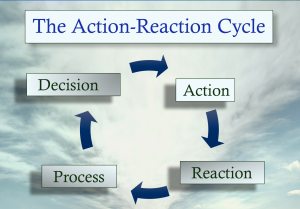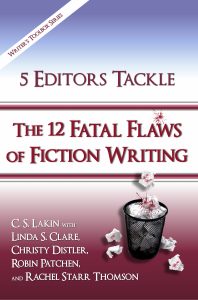The Cycle of Action-Reaction in Novel Scenes
You’re in the middle of reading a book. Suddenly you hear a loud crash outside. It sounds as if a tree just fell on your garage. You run outside and into your driveway. Your mouth drops open.
A spaceship—or what appears to be one—has nosedived into your garage and your brand-new BMW is crushed.
You . . .
- Stomp your feet and fume. Now you’re going to have to call a tow truck and haul your baby to a repair shop. And what’s the likelihood you’ll get your $1,000 deductible back? I mean, really, who exactly can you file a claim against? you wonder as you stare at the clearly alien vehicle that is smoldering on your roof.
- Totally freak out in fear. Seriously—aliens have invaded Earth, and they just happened to have crashed your house. Panic strikes as you worry about your three kitties. Where are they, and can you round them up before Martians make a quick lunch of them? They eat cats, right? You go screaming into the house.
- You stand in awe. How cool is this? Good thing you have your smartphone in your pocket. Think how much money you’ll make selling the video of the first aliens on Earth. You can hardly control your wiggling and squealing as you wait for some door to open on the spacecraft.
 Well, this may not sound much like real life. But actually, it should sound realistic to you—for one particular reason: you just witnessed the natural process of action-reaction.
Well, this may not sound much like real life. But actually, it should sound realistic to you—for one particular reason: you just witnessed the natural process of action-reaction.
Get Your Characters Acting Naturally
I decided to write a post about this because, yet again, in a current manuscript I’ve been critiquing, I am writing in the the comments: “What’s his reaction? How does this make him feel? You’re in his head, so what is he thinking?”
I can’t tell you how many times I write this (or something similar). Which tells me this is a problem for some writers. More like an oversight.
Writers get so busy elaborating on plot in scenes, they don’t stop to consider what’s important. And that’s conveying a realistic flow of behavior for their characters.
Even with fast-action scenes, there is time for this “action-reaction” cycle.
Some instructors put it this way: There’s an action (something happens, such as a character hears a loud crash). Your character reacts (she runs outside and sees a spaceship stuck in her garage). Then she processes (which can take one line or an entire chapter—that’s going to vary depending on many factors) what she just experienced (thinks, emotes, feels). That processing then turns to a new action (run, scream, faint, pull out your smartphone).
So this cycle is essentially action-reaction-process-decision. Repeat.
 Certainly not every scene is set up this way, but think about it. If you want your characters to act in believable ways, they need to react to what’s going on around them. If you are in a character’s POV, whether first or third person, your character needs to react to things.
Certainly not every scene is set up this way, but think about it. If you want your characters to act in believable ways, they need to react to what’s going on around them. If you are in a character’s POV, whether first or third person, your character needs to react to things.
So many manuscripts I edit and critique show a character hearing some news or witnessing something occurring around them, and they have no reaction. They just move on to the next plot development. Or there might be two people talking and they keep bringing up important or interesting bits of information.
But do either of them react or process what’s being said? No. There are no narrative beats, no showing of expression, gesture, body language, thoughts—nothing to show they heard what the other person just said. Oh wait, they quickly replied, so surely they heard. Right?
Well, sure. But it doesn’t sound natural. There is no believable process or cycle of action-reaction taking place. As a result, the scene is rushed, awkward, clunky. Off.
Listen to this:

“Sally, I have to tell you something,” George says.
“What?” she answers.
“I’ve decided to leave you.”
“After all these years? How could you do this to me?”
“Well, I went through the credit card charges. Just who do you think you’re fooling?”
“What do you mean?” Sally asks.
“All those hotel charges. You’re seeing Bill again, aren’t you?”
“Oh, George. You’re wrong. Remember my sister I told you about—the one who was on the streets taking drugs? She came back into town. She’s in trouble. I’m just trying to help her. I didn’t want to tell you.”
“Why not? I’m your husband. Are you giving her money?”
“Of course. Wouldn’t you, if it was your sister?”
“We can’t afford it. What are you thinking?”
Sally starts to cry. “Maybe you should leave me. I’m not going to turn my back on my sister, druggie or not.”
I just rattled that off. This is what a lot of writers do. They can see the scene in their head. They know what their characters are feeling. They know the tone of the words being said. But similar to emailing and texting, we can’t really know the tone of the words.
Don’t you just hate that? So often we misunderstand (or are misunderstood) when we email or text because we can’t see the other person’s reaction, his facial expression or gestures. We can’t hear his tone of voice, the emotion behind the words. Words are just groupings of letters that denote certain things.
But subtext? Intent? We can’t know those things just from printed words.
Some of this was covered in our monthlong look at Description Deficiencies and Excesses last year in the 12 Fatal Flaws posts on this blog. Too often important things are left out of scenes because writers don’t stop to think what exactly they’re conveying to their readers.
If you succumb to this flaw, be sure to spend some time reading the posts and the sample passages to help you spot this problem as well as see ways to fix it (or buy the book here).
So here’s the way to avoid leaving out what’s important—the way to avoid creating deficient scenes.
Check your scenes to make sure you have this action-reaction cycle going. If you haven’t written a scene yet, as you plot it out, pay attention to this cycle. This may be wholly an action scene. That’s fine. But the next scene better be the reaction.
Great suspense/thriller novels will have high action and often end the scene without showing any reaction, but the character is positioned in such a way that you know that reaction is coming. He’s standing on the edge of the precipice watching his enemy suddenly fall into the crevasse and scream as he falls to his death.
Or that scene might end with the POV character reacting just briefly.:
Max gasped as he screeched to a stop, rocks tumbling into the ravine at his feet. His heart pounded in his throat as he watched Daryl slip, flailing, into the dark abyss, the ground churning and groaning beneath him.
Max shook his head, trembling. “Better you than me, dude.”
Genre Determines the Length of Each Component
Genre will often determine how this cycle will play out. Where the reactions will come in scenes. How much “processing” a character does. Thoughtful women’s fiction may show a character processing (thinking through) for a whole chapter something that just happened. Other genres may only show a line or two of processing before a decision is made. And then the time will vary between decision and new action.
Best way to know how much time to spend on each segment of this cycle? Study best sellers in your genre. Pull out a bunch of novels and read through the scenes, jotting down notes as you see a character act, then react, then process, then decide.
This is so important to crafting believable scenes. Take some time and go through some of your scenes. Note this cycle. What are you missing? Are you lacking in reaction? Or do you have too much reaction or processing?
Another big problem is found in scenes that go on and on, with characters thinking (processing) and rehashing the same stuff over and over and not making a new decision, not acting with a new action. That’s going to bore your readers. I’ve edited manuscripts in which characters sit around for upwards of a hundred pages without moving into decision and new action.
You want a balance, but again, it should fit genre. I love mysteries in which the detectives do a lot of processing as they try to solve a complex crime. But along with all that processing is a ton of suspenseful action, twists, complications, setbacks, and misdirection.
I hope this look at the action-reaction cycle has got you geared up (pun intended—yeah, it’s a weak one) to dive into your scenes and make sure they have characters acting and reacting to everything.
Mastering the action-reaction cycle is essential to crafting characters that are believable. My online course Emotional Mastery for Fiction Writers goes deep into this process and teaches you how to effectively show emotion in your characters. And you can watch the action-reaction module for free! Check it out HERE!
Just for a treat, I hope you enjoy this blast from the past. Remember: you want your characters to act naturally!
Your thoughts? Were you aware of this cycle? What part of this action-reaction cycle do you struggle with?












Great post. Will reblog. Thank you!
I am very aware of this dynamic because of a basic background I have in the craft of acting. Acting-reacting is essential to creating a realistic scene on the stage. I find this has helped me in writing my own work. One of the many aspects I’m focusing on in revising my novel is this action-reaction dynamic. It so enriches the story. Your advice is always right on. Thank you.
You’re welcome! This, to me, is one of the most important aspects to scene writing, and I haven’t really discussed it (and never see it discussed on blogs).
This post went a long way to settling my mind. My previous novel was a high octane thriller with plenty of action and some processing as well. The novel I’m working on now is set more in a paranormal/romance genre. I’ve been concerned that I’ve been processing a little bit too much, especially when compared with my previous novel, but it has still felt right. Though it’s rather obvious now, I hadn’t considered the difference in attention given to processing between genres. Thanks for illuminating this for me.
I agree with this mostly, but I’ve also had readers comment that there’s too much reaction/internal processing going on in my writing from time to time. I write YA–teens tend to react! But I do wonder sometimes whether the internal stuff is distracting in a scene. How to tell?
“Sally, I’m breaking up with you.” George said.
“What?” He couldn’t be serious.
“You heard me. We’re done.”
“But…” she tired to hold back tears but failed. “But I love you!”
“I know, I know you do,” George said. “But I can’t stand between you and Billy anymore.”
“Why would you do this to me?” Why did he always assume she was hanging out with Billy, and why did it even matter?
“I’m sorry, Sally.”
Now how was she going to help her sister?
There’s a lot that I’ve omitted, but a lot of that stuff can be added in later, keeping the writing guessing.
“Sally, I”m breaking up with you.” George said.
“What?” He coudln’t be serious.
“You heard me. We’re done.”
“But…” she tired to hold back tears but failed. “But I love you.”
“I know, I know you do,” George siad. “But I can’t stand between you and Bill anymore.”
“Why would you do this to me?” Why did he always assume she was hanging otu with Billy, and why did it matter?
“I’m sorry, Sally.”
Now how was she going to help her system.